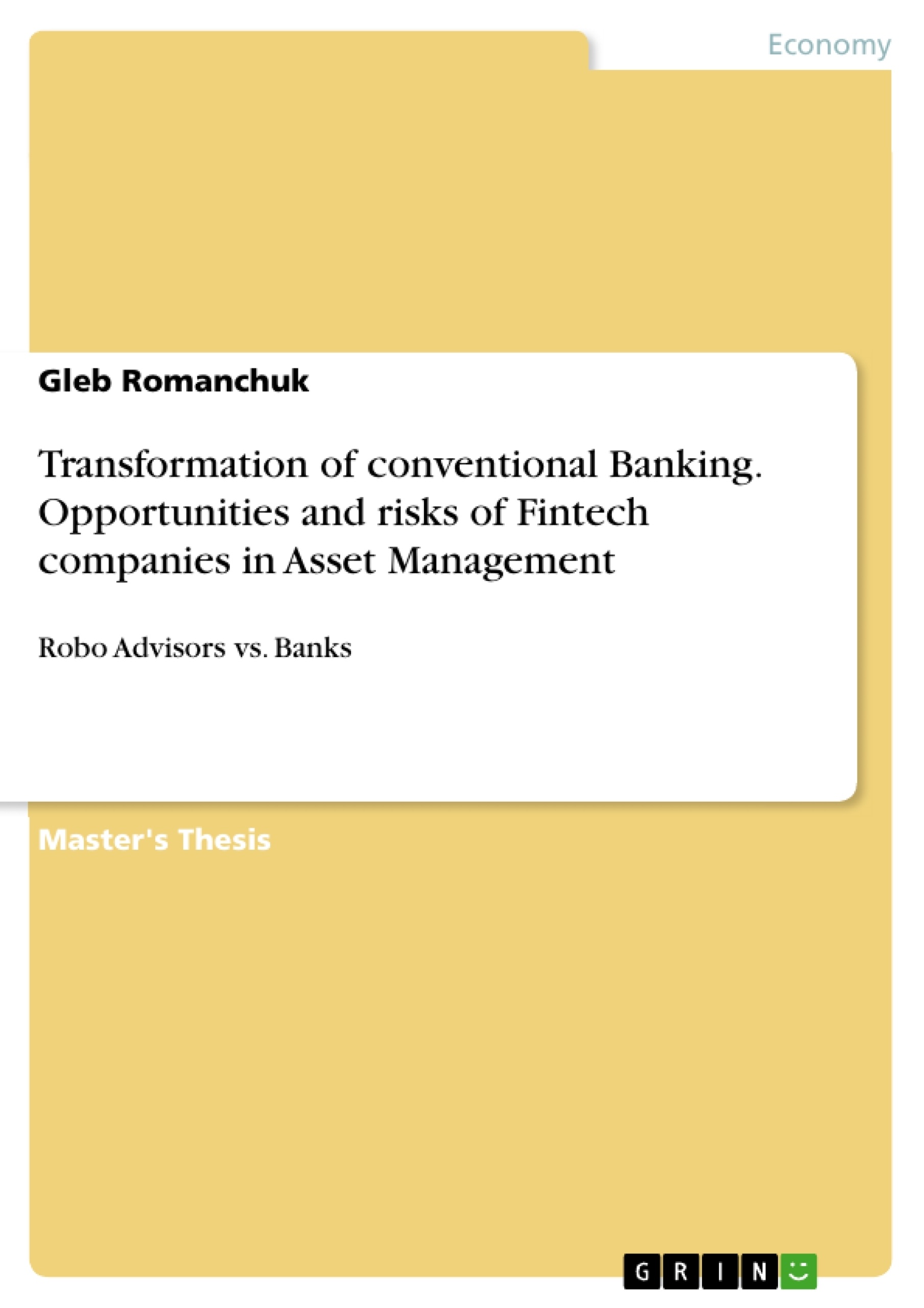The purpose of this work was to find out whether Fintechs are able to compete with Banks in the field of Asset Management. Companies providing Robo Advisory services are considered to be the banks of the future. Several interviews with companies working in this field have been conducted to investigate if the algorithms are prepared for the next financial crash.
This work contains 7 chapters, starting with the motivation and research question. Sec-ondly, the general situation on the market will be described, including the changes of customer behavior. This serves the purpose to give an understanding about the current market conditions. Thirdly, the banking sector will be described, considering definitions and regulations. In this work the focus will be on the German market, therefore, con-sumer behavior and details about the German retail banking industry are relevant. Sub-sequently, chapter 4 deals with asset management and the new trends in the industry. Chapter 5 describes the development of the fintech industry. Definitions and regulations of the fintech companies are part of this chapter. In chapter 6 the scientific investigation will be conducted and presented. The results will show how stable the new technologies are, in order to give an outlook for the future in the next chapter. Prospects for the future of retail banking and especially asset management will be mentioned in chapter 7. General current trends and forecasts are also part of this chapter.
Since only limited literature is available about the fintech industry and especially robo advisory, the investigation part includes a qualitative approach with interviews that have been conducted with qualified specialists that work or research in the robo advisory industry. The question of whether and how the robo advisors will survive the next fi-nancial crisis, is topic of the interviews. There has been no financial crisis that might have caused unforeseen problems for the systems, ever since the creation of robo advi-sory. Thus, it is unknown how those technologies will react to chaotic market situations. The idea was to ask companies to what extent they are prepared for a financial crisis. The findings of this investigation will deal with the possible future outline of those fintechs providing algorithm-based asset management. The question about the security framework has been answered with a view to examining the future development of the robo advisory industry.
Inhaltsverzeichnis (Table of Contents)
- Introduction
- Relevance of the topic
- Research question
- Structure and approach
- Changes on the market
- Overview
- Digitalization
- Changes in customer behavior
- Internet
- Mobile
- Banking
- Banking in Germany
- Retail Banking in Germany
- New trends of Retail Banking
- Asset Management
- Type of Investors
- Service Type
- Place of Service and Investment Objective
- Market Participants
- Processes
- Intermediaries
- Fintech
- Definition
- Impact of Fintech
- Impact of Robo Advisors
- Asset Management
- Personal Financial Management
- Robo Advisory
- German market in comparison
- Regulations for Robo advisors
- Legal classification of Robo Advisory models in Germany
- Analysis of the Business Model
- Business Model Canvas
- Key Partners
- Key Activities
- Key Resources
- Value Proposition
- Customer Relationships
- Channels
- Revenue Streams and Cost Structure
- Customer segments
- Investigation
- Introduction
- Aim of research
- Structure
- Results
- Characteristics of the companies
- Answers
- Analysis
Zielsetzung und Themenschwerpunkte (Objectives and Key Themes)
This master's thesis examines the transformation of conventional banking in the context of rising Fintech companies, specifically focusing on the impact of these companies in the asset management sector. It explores the opportunities and risks associated with this shift, investigating the changing landscape of banking and its implications for both traditional institutions and emerging Fintech players.
- The impact of digitalization on the banking and asset management sectors
- The emergence of Fintech companies and their disruptive potential
- The evolving needs and behaviors of customers in the digital age
- The regulatory framework surrounding Fintech companies and Robo Advisors
- The analysis of Robo Advisor business models and their potential for success
Zusammenfassung der Kapitel (Chapter Summaries)
- Introduction: This chapter establishes the relevance of the topic by highlighting the transformative impact of Fintech companies on the banking and asset management industry. It also outlines the research question, the structure of the thesis, and the approach taken.
- Changes on the Market: This chapter provides an overview of the key changes occurring in the market, including the increasing role of digitalization, the evolving needs of customers, and the growing influence of the internet and mobile technologies.
- Banking: This chapter examines the state of banking in Germany, focusing on the characteristics of retail banking and the emerging trends shaping the industry.
- Asset Management: This chapter explores the different types of investors, service offerings, investment objectives, and key market participants in the asset management sector. It also delves into the processes and intermediaries involved in this industry.
- Fintech: This chapter defines Fintech and its impact on the financial services industry, with a particular focus on Robo Advisors and their influence on asset management. It examines the German market in comparison to other regions, analyzes regulations for Robo Advisors, and explores the legal classification of Robo Advisory models in Germany.
- Investigation: This chapter presents the results of the research, analyzing the characteristics of selected Fintech companies, providing answers to the research questions, and offering a detailed analysis of the findings.
Schlüsselwörter (Keywords)
This master's thesis explores the transformation of conventional banking and the opportunities and risks presented by Fintech companies in asset management. Key themes include digitalization, customer behavior, Fintech innovation, Robo Advisors, regulatory frameworks, business model analysis, and the impact on the German market.
- Quote paper
- Gleb Romanchuk (Author), 2019, Transformation of conventional Banking. Opportunities and risks of Fintech companies in Asset Management, Munich, GRIN Verlag, https://www.grin.com/document/461793



